
Authentic Nata De Coco Recipe
This recipe provides a detailed guide on how to make Nata de Coco at home, a popular Southeast Asian dessert made from fermented coconut water. The process involves mixing coconut water with sugar and vinegar, adding a starter culture, and fermenting the mixture for several days. The resulting Nata de Coco is a chewy, translucent, and jelly-like substance that can be used in various desserts and beverages.
Equipment
- 1 Large casserole
- 1 Cheesecloth or fine mesh sieve
- 1 Rubber band or string
- 1 Glass container for fermentation
Ingredients
- 500 ml coconut water
- 200 gram sugar
- 10 ml vinegar
- 10 ml Starter bacteria (Acetobacter Xylinum)
Instructions
- Pour the water into a large casserole
- Boil the coconut water
- Add the sugar and the vinegar into the boiling water. Stir until the sugar is completely dissolved.
- Remove the casserole from the heat and pour the mixture to a glass bowl. Wait for the temperature to drop to 30 Celsius degrees.
- Pour 10 ml of the starter bacteria in the water
- Cover the container with cheesecloth or a thin fabric, securing it with a rubber band or string. This allows air circulation while preventing contaminants from entering.
- Let Rest for 10 - 12 days
- After a few days, you should start to see small jelly-like pieces forming. The fermentation is complete when the liquid has thickened, and the nata de coco pieces are firm and translucent.
- Once the fermentation is complete, carefully strain the liquid through a fine mesh sieve or colander to separate the nata de coco from the liquid. Rinse the nata de coco pieces under cold water to remove any residual acidity.
- To eliminate any remaining acidic taste or smell, soak the nata de coco cubes in several changes of fresh water. The soaking process typically takes at least 2 days, but you can adjust the duration based on your preference.
Video
Notes
- Use fresh coconut water for the best results.
- Ensure cleanliness and sterilize equipment to minimize the risk of contamination during fermentation.
- Monitor the fermentation process regularly to adjust the time as needed.
- Experiment with different flavors by adding sugar or other sweeteners during the soaking process.
- Store the Nata de Coco in an airtight container in the refrigerator to preserve freshness.
- You can buy Acetobacter Xylinum or from Custom Probiotics.